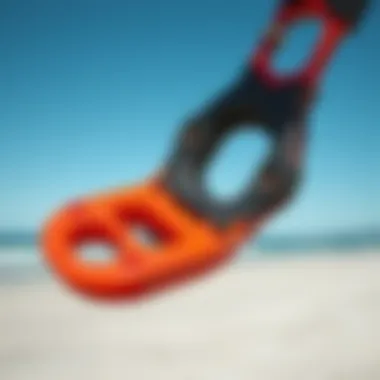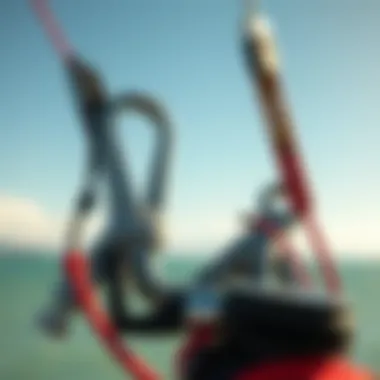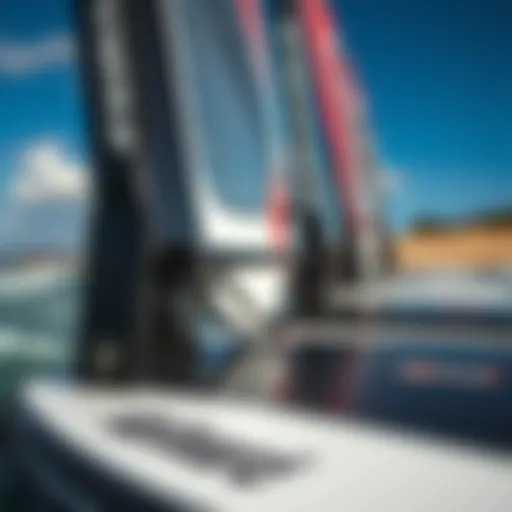Understanding Quick Release Mechanisms in Kiteboarding


Intro
When it comes to kiteboarding, safety and functionality are everything. Kiteboarders are always seeking ways to improve their performance on the water, and one key component that plays a significant role in both safety and efficiency is the rope quick release mechanism. This intuitive piece of gear can be the difference between a smooth ride and a disastrous tumble. Understanding how quick release systems work can empower enthusiasts to make informed decisions about their equipment and, more importantly, keep them riding away from trouble.
The core of a quick release mechanism is its design, crafted for immediate response in emergencies. When everything is going at full speed, knowing that you can disengage from your kite quickly provides peace of mind. This section will take a deep dive into the different facets of quick release systems, revealing the intricacies that keep kiteboarders safe.
Kiteboarding isn't merely about the thrill; it's about mastering your craft and having the right gear to back you up. Let's kick things off by taking a closer look at the gear and equipment related to these mechanisms.
Gear and Equipment
Essential Kiteboarding Gear: A Comprehensive Guide
No kiteboarder can afford to fly solo without the proper equipment. A well-rounded setup isn't just nice to have; it’s a necessity. Every piece plays a pivotal role in not only enhancing performance but also ensuring safety. Here’s a rundown of the essential gear you’ll want to familiarize yourself with:
- Kite: The heart of your kiteboarding experience; sizes vary based on wind conditions and rider preferences. Selecting the right kite can transform your entire outing.
- Board: Comes in various shapes and sizes; tailored for different riding styles. A good board syncs seamlessly with your kite, ensuring smooth landings and great control.
- Harness: Safeguards the connection between you and the kite. The design influences comfort and how well you can initiate a quick release.
- Quick Release Mechanism: Arguably one of the most critical parts. Depending on the system, features may vary, which can significantly affect your experience. To avoid mishaps, it’s invaluable to understand how each type operates.
- Leash: A tether that keeps your equipment close. It can be a lifesaver when things go south.
"The gear is just as important as the skill; you wouldn’t trust a broken compass at sea, neither should you trust faulty gear in kiteboarding."
Maintenance Tips for Kiteboarding Equipment
Proper maintenance extends the lifespan of your gear and ensures optimal performance. It’s not rocket science, but it does require some diligence. Here are a few pointers to keep your setup in tip-top shape:
- Regular Inspections: Check your harness, lines, and quick release mechanisms frequently. Look for signs of wear and tear, fraying, or damage. A stitch in time saves nine.
- Clean Your Gear: After each session, rinse your equipment with fresh water. Sand, salt, and debris can wear down your gear over time, leading to malfunctions.
- Store Properly: Keep everything in a cool, dry place away from direct sunlight. This simple step helps prevent material degradation.
- Replace Worn Parts: Don’t hesitate to replace any part that shows significant wear. Consider using quality products like those from Naish or Cabrinha for replacements.
Techniques and Skills
Beginner Techniques to Get Started with Kiteboarding
For those just dipping their toes into the kiteboarding waters, starting off properly will lay the framework for your progression. Here are a few fundamental techniques:
- Understanding Wind Conditions: Knowing how to read the wind is crucial. This skill will determine when you hit the water and what gear is best.
- Body Dragging: Before getting on a board, practice body dragging. This experience will familiarize you with how a kite pulls through the air.
- Water Starts: Once confident, it is time to have your first water start. Balance is key, as well as the right timing in harnessing the kite's power.
Advanced Maneuvers for Seasoned Kiteboarders
As you gain confidence, the next step is mastering advanced techniques. Here are some to aspire to:
- Jumps and Tricks: With practice, you can learn to jump higher and perform tricks. Remember, practice makes perfect!
- Unhooked Riding: For experts, unhooked maneuvers add flair but require a solid understanding of quick release operations and timing.
- Transitioning: This is the ability to switch directions smoothly. Refining this technique can elevate your style on the water.
For more information about kiteboarding gear and techniques, visit resources like Wikipedia or Britannica.
Don't forget to engage with other enthusiasts on platforms like Reddit or Facebook groups dedicated to kiteboarding. Safe riding!
Prologue to Rope Quick Release Systems
In kiteboarding, the importance of rope quick release systems cannot be understated. These mechanisms serve as a crucial safety feature, designed to allow riders to detach from their kites quickly in emergency situations. Whether it's the kite tangling, unexpected gusts of wind, or equipment failure, a reliable quick release can mean the difference between a minor inconvenience and a serious accident.
Importance of Quick Release in Kiteboarding Gear
The essence of a well-functioning quick release system lies in its role during high-pressure moments. Kiteboarding entails freedom and exhilaration, but it comes with inherent risks. The ability to disconnect instantly empowers riders, granting them control over their safety.
Consider this: during a wipeout or when caught in a dangerous pull, the rider can pull a trigger or press a button, effectively releasing themselves from the kite's dynamic forces. This swift disengagement aids in preventing injuries that might occur due to being dragged over water or colliding with obstacles. Moreover, when assessing gear, many riders seek out systems that are not only reliable but also intuitive to use. It's essential that these systems be easy to engage and disengage, even in moments of panic.
- Enhanced safety during unexpected situations
- Rider confidence knowing they can release their kite quickly
- Prevention of potential injuries and accidents
- The simplicity of operation promotes safe practice


Basic Concepts of Quick Release Mechanisms
Understanding the basic concepts behind quick release mechanisms is key to appreciating their functionality. At their core, quick release systems operate on straightforward principles, balancing ease of use with robust design.
Most mechanisms involve a locking mechanism that holds the kite lines securely in place until activated. When the rider decides to release, a trigger or lever is manipulated to disrupt this locking mechanism, allowing the lines to detach.
Additionally, the types of quick release systems vary, encompassing mechanical, magnetic, and electronic options—each with its own set of advantages and challenges. Recognizing these differences will help riders choose systems that align with their specific needs and preferences, enhancing both their performance and safety.
In summary, rope quick release systems form the backbone of safety in kiteboarding, functioning to allow rapid disengagement in critical moments. By grasping their importance and understanding their basic operation, kiteboarders equip themselves with the knowledge needed to sail confidently, advocating for responsible and informed usage of their gear.
Types of Quick Release Systems
In the realm of kiteboarding, the type of quick release system you choose can often dictate your safety and effectiveness on the water. Understanding these systems is essential because they function as the life-line control when maneuvers go awry or when an emergency situation arises. Each quick release mechanism—be it mechanical, magnetic, or electronic—offers distinct operational benefits along with considerations that must be evaluated by riders and gear manufacturers alike. Let's delve deeper into each variant.
How Quick Release Mechanisms Function
In kiteboarding, understanding how quick release mechanisms work is crucial. These mechanisms not only provide safety but also enhance the overall performance of the sport. By knowing how they function, a rider can effectively deploy them during critical moments, ensuring both speed and safety. The focus here will be on the mechanics behind the engagement and disengagement processes, along with how these systems interact with standard kiteboarding equipment.
Mechanics Behind Operation
Engagement Process
The engagement process refers to how the quick release mechanism latches securely to your kite’s lines and bar system. The key characteristic of this process is its intuitive operation—most designs allow for a seamless attachment that can be easily engaged while riding. This system is a popular choice for many kiteboarders because it combines user-friendly mechanics with reliable functionality.
One unique aspect of the engagement process is its capacity for customization. Riders can often adjust the tension with which the mechanism engages, offering some degree of personalization based on individual preferences and safety thresholds. This feature is advantageous, as it helps in tailoring the kiteboarding experience to the rider’s specific needs.
However, one should also acknowledge potential disadvantages. If the engagement is too tight, it might lead to significant strain during extreme maneuvers, risking damage to the lines or the mechanism itself. Therefore, while the engagement process is designed for efficiency, careful attention is needed to maintain its integrity.
Disengagement Process
Conversely, the disengagement process involves how a rider can release the kite from the safety system. This aspect is vital, as a rapid release can mean the difference between avoiding a danger or facing a serious accident. This is where the key characteristic of a quick release mechanism shines: it provides immediate disengagement, allowing riders to react swiftly in emergencies.
A notable feature of the disengagement process is the visual indicators present in certain designs. These indicators help riders ensure that the release mechanism is properly set up for immediate action. As a result, riders can maintain focus on their performance without second-guessing their gear.
On the downside, disengagement mechanisms requiring excessive force can lead to accidental triggers, putting the rider at unnecessary risk. Balancing ease of use with safety can sometimes be challenging in this context.
Interaction with Other Kiteboarding Equipment
Bar Systems
The bar system in kiteboarding plays a pivotal role in how quick release mechanisms function. The main purpose of the bar is to control the kite like a steering wheel. The key characteristic of bar systems is their comprehensive integration with both the lines and the quick release system.
This integration means that when a rider pulls on the bar, it not only directs the kite but also initiates the tension needed for the quick release to engage properly. Therefore, the effectiveness of the bar system directly correlates with the reliability of the quick release mechanism, which is why these components often come together as a package.
However, complexities can arise. For instance, whether a rider uses a high-performance bar or a more standard design can affect the mechanical efficiency during critical times. Understanding which system works best with their quick release gear is essential for each kiteboarder, impacting their performance significantly.
Harness Connections
Harness connections serve as the anatomical link between the rider and the kite. These connections are typically designed with safety in mind and play an equally important role in the function of quick release systems. The key characteristic of harness connections is their field-tested reliability; they are designed to withstand significant pressure without failure.
One unique feature of modern harness connections is their ability to accommodate various quick release mechanisms. This versatility makes them beneficial for riders who switch between styles or brands. For example, a connection designed to fit a specific quick release system might also be compatible with a newer model, allowing for easy upgrades without a complete equipment overhaul.
Nevertheless, potential pitfalls exist. Many riders opt for simplistic harness styles without understanding how they may impact quick releases during a fall or other sudden movements. Proper education on harness design and the compatibility of quick release mechanisms can greatly affect overall safety.
Keeping abreast of these interactions is pivotal for maximizing both safety and speed on the water.


Safety Considerations in Using Quick Release Systems
When engaging in any extreme sport like kiteboarding, safety is paramount. Quick release systems play a critical role in ensuring the rider can disengage from their kite safely and swiftly when necessary. Failing to understand how these mechanisms function — or neglecting their maintenance and proper use — can lead to severe accidents, even for the most seasoned of kiteboarders. So, let’s take a close look at some pertinent safety considerations.
Potential Risks of Malfunction
The risks associated with a malfunctioning quick release system are significant. Riders rely on these devices to detach themselves from the kite, particularly in emergency situations. If the mechanism jams or fails to operate, a rider could be pulled dangerously by the kite. Here are a few potential risks to keep in mind:
- Improper Engagement: Sometimes, quick release systems may not latch correctly during setup. Riders need to check this before hitting the water.
- Wear and Tear: Continuous exposure to saltwater and UV rays can weaken the components of the quick release system. Regular checks to ensure the integrity of materials used are vital.
- Inadequate Testing: Just because a system looks fine on the surface doesn’t mean it’s working correctly. Routine testing ensures it releases smoothly when activated.
As kiteboarding enthusiasts, being cautious about these risks might just save a life. After all, inaction can often be far more dangerous than over-preparation.
Proper Use and Handling
Proper use and handling of quick release mechanisms cannot be overstated. Familiarity with a system not only enhances safety but also boosts confidence while riding. Here are some best practices:
- Education on Usage: Before stepping onto the water, read the manual or guidelines provided by the manufacturer. Know how your specific quick release system is supposed to function.
- Routine Checks: Develop a habit of checking your system before each session. Ensure flexibility and smooth operation — look out for any signs of corrosion or damage.
- Operating with the Right Technique: In an emergency, knowing the right way to engage the quick release can make all the difference. Practice this technique regularly until it becomes second nature.
- Storage and Transport: When not in use, proper storage can protect your equipment from the elements and potential damage. Avoid leaving gear exposed to harsh conditions.
"Regular maintenance is not just about looking good; it's about safety. Your life may depend on it."
Staying informed and taking ownership of your equipment’s condition can help prevent mishaps on the water. Ultimately, kiteboarding should be a thrilling experience, not a hazardous one.
For further understanding, consider checking out resources from organizations like Kiteboarding Association or forums on Reddit. Staying engaged with fellow kiteboarders can also enhance safety knowledge and promote best practices in gear handling.
Maintenance of Rope Quick Release Systems
Maintaining rope quick release systems is a critical aspect of kiteboarding that is often overlooked. Riders must remember that these mechanisms are not just technical components; they are lifelines during critical situations on the water. Proper maintenance is vital to ensure they operate flawlessly when needed. Without regular care, the performance of these systems may diminish, leading to potential safety issues.
In this section, we will cover the significance of routine inspections and tests, along with proper cleaning and lubrication procedures. By following these guidelines, kiteboarders can improve the reliability of their gear and enhance their overall kiteboarding experience.
Regular Inspections and Tests
Regular inspections and tests of rope quick release systems play an essential role in identifying wear and tear before they lead to failures. Riders should adopt a proactive approach in examining their gear. Some key points to focus on during these inspections include:
- Visual Checks: Inspect for any visible signs of damage, such as fraying of ropes or cracks in the release mechanism. A small tear can escalate, compromising safety.
- Functional Tests: Physically engaging and disengaging the quick release feature ensures it operates smoothly. Any stiffness or resistance may signal an underlying issue.
- Stress Testing: Apply tension to the system to confirm that it performs under pressure. This helps ensure that it will function correctly during real-world situations.
Incorporating these inspection routines into your regular pre-ride ritual can make a substantial difference in ensuring you're ready for a safe session on the water.
"An ounce of prevention is worth a pound of cure." Regular inspections will save you from delicate situations down the line.
Cleaning and Lubrication Procedures
Keeping the quick release systems clean and adequately lubricated is just as vital as performing regular checks. Dirt, sand, and saltwater can accumulate over time, affecting the performance of the mechanism. Here's how to maintain them:
- Cleaning: After every session, rinse the components with fresh water to remove any debris. Use a soft cloth to wipe down all surfaces, ensuring moisture is not trapped in moving parts.
- Lubrication: Apply a proper lubricant suitable for marine equipment. This will help maintain the smooth operation of the quick release system and prevent rust from developing. Remember that too much lubricant can cause a buildup that might impede functionality, so a light touch is best.
Considerations:
- Always follow manufacturer guidelines regarding cleaning and lubrication.
- Be mindful of parts that are sensitive to specific cleaning agents, as harsh chemicals can cause damage.
By consistently practicing these maintenance tips, kiteboarders can significantly prolong the lifespan of their rope quick release systems and ensure safety on the water.
Comparative Analysis of Various Systems
Conducting a comparative analysis of various quick release systems is essential in understanding not just their unique features, but also how these features translate to real-world applications in kiteboarding. This section aims to break down performance metrics and user feedback to give an all-around view on what’s hot, what’s not, and why certain systems might suit a kiteboarder better than others.


Performance Metrics
When discussing quick release systems, performance metrics are a vital point of reference. They help users make informed choices based on how effectively these systems operate under pressure. Key performance metrics can include:
- Release Time: The speed at which the mechanism disengages from the rider when needed. Systems that react quicker can be life-saving in emergency situations.
- Force Required for Release: Analyzing how much force is needed to activate the system is crucial. If it requires too much effort, it might hinder a rider’s ability to react swiftly in critical scenarios.
- Durability and Wear Resistance: Over time, components can wear down, especially under harsh conditions. The longevity of materials affects how often a rider needs to replace or maintain their gear.
- Compatibility with Other Equipment: A system should ideally integrate seamlessly with other kiteboarding apparatuses, such as bars and harnesses.
Performance metrics give kiteboarders clarity on which systems will hold up when the chips are down.
The above metrics provide a framework for evaluating quick release systems. Each system may perform differently under specific circumstances, so understanding the nuances is key. This analysis can help users determine which features might be more beneficial depending on their riding style and conditions they generally face on the water.
User Feedback and Experiences
Nothing can paint the complete picture of a product’s effectiveness like the voices of those who use them. User feedback offers insight into the real-world reliability of quick release mechanisms. The spectrum of experiences can provide clarification about their strengths and weaknesses. Key considerations include:
- Ease of Use: Many riders value a system that can be operated with one hand. Complaints often arise when a product is complex or awkward to engage.
- Real-Life Performance: Riders share stories about how their systems performed in sudden situations—lots of positive and informative anecdotes help gauge reliability.
- Maintenance Experience: Some users might report difficulties in maintaining their gear, such as keeping parts clean and functional over time.
It can be beneficial for prospective buyers to check platforms like Reddit or specialized forums for community discussions and reviews. Seeing what other kiteboarders have encountered can assist in making a choice that best suits individual needs.
In this era where safety can’t be compromised, it becomes clear that evaluating quick release mechanisms doesn't just hinge on specs or shiny materials. User experiences serve as the backdrop of knowledge that can inform and guide both novice and seasoned kiteboarders.
For more detailed discussions on performance metrics and personal stories, you can visit forums like Reddit or check out articles on Britannica that delve deeper into safety gear evaluations.
Future Trends in Quick Release Technology
As kiteboarding continues to grow in popularity, the need for advanced quick release mechanisms becomes increasingly important. Future trends in quick release technology focus not only on enhancing safety but also on improving rider experience and performance. As manufacturers invest in research and development, kiteboarders will benefit from innovations that streamline the use of equipment, reduce weight, and increase reliability under various conditions. The evolution of quick release systems is pivotal in ensuring they remain effective in emergencies while being user-friendly for enthusiasts of all skill levels.
Emerging Materials and Designs
Innovations in materials play an essential role in the future of quick release mechanisms. Kiteboarding gear is subject to intense strains, exposure to saltwater, wind, and sun, which can affect the integrity of components over time. In recent years, the adoption of high-performance polymers, such as thermoplastic elastomers and ultra-high-molecular-weight polyethylene, has seen a rise. These materials offer enhanced durability and flexibility while remaining lightweight, directly impacting the performance and longevity of quick release systems.
New designs are also being considered, blending functionality with aesthetics. For instance, development in 3D printing allows for customized components that meet specific rider needs. This production method enables quick prototypes that can be tested in real-world conditions, promptly identifying flaws and refining designs before mass production.
Another aspect to consider is the integration of modularity. Manufacturers are focusing on modular designs that allow for easy replacement of specific parts without needing to discard entire systems. This not only extends the lifespan of quick release mechanisms but also introduces an element of sustainability into the kiteboarding gear cycle.
Case Studies of Innovative Solutions
In diving into real-world applications, several brands have implemented innovative solutions to address long-standing issues related to quick release mechanisms. For instance, Liquid Force has been at the forefront with their "The 1X Quick Release" system. This design features an intuitive operation, allowing users to engage and disengage with minimal effort while ensuring a robust safety mechanism, greatly reducing the likelihood of accidental releases.
Another noteworthy example comes from North Kiteboarding, where they introduced an electronic quick release system equipped with a safety alert feature. This technology uses sensors to monitor tension and automatically trigger a release if certain thresholds are exceeded, providing an additional layer of safety for kiteboarders.
In addition to specific products, brands like Cabrihna are pioneering collaborative approaches to innovation. Their recent project involved kiteboarders who tested prototypes in various conditions, providing valuable feedback that led to refinements in design and functionality, ensuring the end product meets the practical needs of users.
End: The Impact of Rope Quick Release on Kiteboarding Safety
Rope quick release mechanisms play a pivotal role in kiteboarding safety. They are the unsung heroes that, in moments of peril, can literally save a life. The effectiveness of these systems hinges not only on their design but also on how well they are integrated into the overall kiteboarding setup. Whether you are a novice or an experienced rider, understanding these safety features should be a top priority; it's not just about performing tricks or catching air, but about ensuring that when something goes awry, you can detach from your equipment with minimal fuss.
The continuous evolution of quick release technology allows for enhancements that address past shortcomings. Through research and feedback from real-world experiences, manufacturers are striving to make these devices more intuitive and reliable. Thus, the importance of familiarizing oneself with these innovations cannot be overstated. A solid grasp of how these mechanisms operate can be the difference between a minor mishap and a serious accident.
Summary of Key Takeaways
- Essential Safety Feature: Quick release mechanisms are fundamental to ensuring emergency detachment from the kite, significantly reducing risks in sudden scenarios.
- Variety of Systems: Familiarize yourself with different types of quick release systems—mechanical, magnetic, and electronic. Each has its unique advantages and disadvantages.
- Regular Maintenance is Crucial: Consistent inspections and maintenance routines are vital to the functionality of quick release systems. Neglect could lead to failure in critical moments.
- Educational Awareness: Riders should not only become adept at using quick release devices but also understand their mechanics to ensure they are used most effectively.
- Community Insights: Engaging with fellow kiteboarders can provide valuable real-world insights, as shared experiences often lend themselves to greater understanding of quick release efficiency.
Encouraging Responsible Usage
Promoting responsible usage of quick release systems in kiteboarding starts with education. Riders must receive sufficient training on how to properly use these devices. Investing time in understanding how and when to engage the quick release can mitigate risks associated with kiteboarding.
Moreover, individuals should lead by example in their kiteboarding communities. When riders prioritize safety and best practices, they set a standard for all. Sharing information about proper handling, regular maintenance, and the latest safety innovations can foster a culture that values precaution and preparedness.
Incorporate preventative measures into your routines. Check your gear before every ride and educate friends about quick release functions. Such collective awareness can have a ripple effect, enhancing safety across the sport as a whole. Remember, in the world of kiteboarding, knowing when and how to disconnect from your equipment can ensure that your next session is both thrilling and safe.
"Riding with confidence is all about knowing that you can go from full send to safe disengagement in the blink of an eye."















